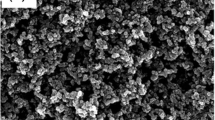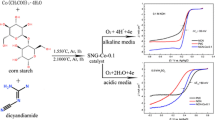Abstract
The production of hydrogen peroxide (H2O2) by 2-electron oxygen reduction reaction (ORR) in acidic electrolytes is a promising alternative to the existing anthraquinone process. However, the development of cost-effective catalysts with high activity for H2O2 electrosynthesis remains a great challenge. Here, we report a cobalt-nitrogen-carbon catalyst in which cobalt single atoms are supported on carbon black (Co-N-CB) for the electrosynthesis of H2O2 in an acid medium. The prepared Co-N-CB shows high activity for O2 reduction into H2O2 with an average selectivity of 80.6% over a wide potential range of 0.1–0.7 V vs. RHE in 0.1 M HClO4 electrolytes. We found that (i) the Co single atoms are the active sites of 2-electron ORR; (ii) a catalyst for efficient H2O2 production by O2 reduction should achieve a good balance between high ORR activity and H2O2 selectivity. Using Co-N-CB as a cathodic catalyst, the electrochemical device could electrosynthesize H2O2 directly from H2 and O2 with a high productivity of 291.0 mol kgcat−1 h−1. Our work provides a flexible way to prepare affordable catalysts for efficient H2O2 electrosynthesis.








Similar content being viewed by others
Data availability
The data that support the plots within this paper, and other findings of this study are available from the corresponding author upon reasonable request.
References
Xia C, Xia Y, Zhu P, Fan L, Wang H (2019) Direct electrosynthesis of pure aqueous H2O2 solutions up to 20% by weight using a solid electrolyte. Science 366:226–231. https://doi.org/10.1126/science.aay1844
Kim HW, Ross MB, Kornienko N, Zhang L, Guo J, Yang P, McCloskey BD (2018) Efficient hydrogen peroxide generation using reduced graphene oxide-based oxygen reduction electrocatalysts. Nat Catal 1:282–290. https://doi.org/10.1038/s41929-018-0044-2
Campos-Martin JM, Blanco-Brieva G, Fierro JLG (2006) Hydrogen peroxide synthesis: an outlook beyond the anthraquinone process. Angew Chem Int Ed 45:6962–6984. https://doi.org/10.1002/anie.200503779
Liu Y, Quan X, Fan X, Wang H, Chen S (2015) High-yield electrosynthesis of hydrogen peroxide from oxygen reduction by hierarchically porous carbon. Angew Chem Int Ed 127:6941–6945. https://doi.org/10.1002/anie.201502396
Melchionna M, Fornasiero P, Prato M (2019) The rise of hydrogen peroxide as the main product by metal-free catalysis in oxygen reductions. Adv Mater 31:1802920–1802924. https://doi.org/10.1002/adma.201802920
Wang Y, Waterhouse GIN, Shang L, Zhang T (2021) Electrocatalytic oxygen reduction to hydrogen peroxide: from homogeneous to heterogeneous electrocatalysis. Adv Energy Mater 11:2003323–2003349. https://doi.org/10.1002/aenm.202003323
Siahrostami S, Verdaguer-Casadevall A, Karamad M, Deiana D, Malacrida P, Wickman B, Escudero-Escribano M, Paoli EA, Frydendal R, Hansen TW, Chorkendorff I, Stephens IEL, Rossmeisl J (2013) Enabling direct H2O2 production through rational electrocatalyst design. Nat Mater 12:1137–1143. https://doi.org/10.1038/nmat3795
Sun Y, Bagger A, Ranjbar N, Ju W, Li J, Zitolo A, Li S, Silvioli L, Arnarson L, Wang X, Möller T, Bernsmeier D, Rossmeisl J, Jaouen F, Strasser P (2019) Activity-selectivity trends in the electrochemical production of hydrogen peroxide over single-site metal-nitrogen-carbon catalysts. J Am Chem Soc 141:12372–12381. https://doi.org/10.1021/jacs.9b05576
Fellinger TP, Hasché F, Strasser P, Antonietti M (2012) Mesoporous nitrogen-doped carbon for the electrocatalytic synthesis of hydrogen peroxide. J Am Chem Soc 134:4072–4075. https://doi.org/10.1021/ja300038p
Zhang Q, Tan X, Bedford NM, Han Z, Thomsen L, Smith S, Amal R, Lu X (2020) Direct insights into the role of epoxy groups on cobalt sites for acidic H2O2 production. Nat Commun 11:4181–4191. https://doi.org/10.1038/s41467-020-17782-5
Gao J, Yang H, Huang X, Hung S, Cai W, Jia C, Miao S, Chen H, Yang X, Huang Y, Zhang T, Liu B (2020) Enabling direct H2O2 production in acidic media through rational design of transition metal single atom catalyst. Chem 6:658–674. https://doi.org/10.1016/j.chempr.2019.12.008
Shen R, Chen W, Peng Q, Lu S, Zheng L, Cao X, Wang Y, Zhu W, Zhang J, Zhuang Z, Chen C, Wang D, Li Y (2019) High-concentration single atomic Pt sites on hollow CuSx for selective O2 reduction to H2O2 in acid solution. Chem 5:2099–2110. https://doi.org/10.1016/j.chempr.2019.04.024
Kuo WG (1992) Decolorizing dye wastewater with Fenton’s reagent. Water Res 26:881–886. https://doi.org/10.1016/0043-1354(92)90192-7
Arnau V-C, Davide D, Mohammadreza K, Samira S, Paolo M, Thomas HW, Rossmeisl J, Chorkendorff I, Stephens IE (2014) Trends in the electrochemical synthesis of H2O2: enhancing activity and selectivity by electrocatalytic site engineering. Nano lett 14:1603–1608. https://doi.org/10.1021/nl500037x
He Y, Hwang S, Cullen DA, Uddin MA, Langhorst L, Li B, Karakalos S, Kropf AJ, Wegener EC, Sokolowski J, Chen M, Myers D, Su D, More KL, Wang G, Litster S, Wu G (2019) Highly active atomically dispersed CoN4 fuel cell cathode catalysts derived from surfactant-assisted MOFs: carbon-shell confinement strategy. Energy Environ Sci 12:250–260. https://doi.org/10.1039/C8EE02694G
Jung E, Shin H, Lee BH, Efremov V, Lee S, Lee HS, Kim J, Antink WH, Park S, Lee KS, Cho SP, Yoo JS, Sung YE, Hyeon T (2020) Atomic-level tuning of Co-N-C catalyst for high-performance electrochemical H2O2 production. Nat mater 19:436–442. https://doi.org/10.1038/s41563-019-0571-5
Sun Y, Silvioli L, Sahraie NR, Ju W, Li J, Zitolo A, Li S, Bagger A, Arnarson L, Wang X, Moeller T, Bernsmeier D, Rossmeisl J, Jaouen F, Strasser P (2019) Activity-selectivity trends in the electrochemical production of hydrogen peroxide over single-site metal-nitrogen-carbon catalysts. J Am Chem Soc 141:12372–12381. https://doi.org/10.1021/jacs.9b05576
Gerber IC, Serp P (2019) A theory/experience description of support effects in carbon-supported catalysts. Chem Rev 120:1250–1349. https://doi.org/10.1021/acs.chemrev.9b00209
Li W, Min C, Tan F, Li Z, Zhang B, Si R, Xu M, Liu W, Zhou L, Wei Q, Zhang Y, Yang X (2019) Bottom-up construction of active sites in a Cu-N4-C catalyst for highly efficient oxygen reduction reaction. ACS Nano 13:3177–3187. https://doi.org/10.1021/acsnano.8b08692
Beckert M, Menzel M, Tölle FJ, Bruchmann B, Mülhaupt R (2015) Nitrogenated graphene and carbon nanomaterials by carbonization of polyfurfuryl alcohol in the presence of urea and dicyandiamide. Green Chem 17:1032–1037. https://doi.org/10.1039/C4GC01676A
Wang M, Zhang N, Feng Y, Hu Z, Shao Q, Huang X (2020) Partially pyrolyzed binary metal-organic framework nanosheets for efficient electrochemical hydrogen peroxide synthesis. Angew Chem Int Ed 59:14373–14377. https://doi.org/10.1002/anie.202006422
Wang Y, Shi R, Shang L, Waterhouse GIN, Zhao J, Zhang Q, Gu L, Zhang T (2020) High-efficiency oxygen reduction to hydrogen peroxide catalyzed by nickel single-atom catalysts with tetradentate N2O2 coordination in a three-phase flow cell. Angew Chem Int Ed 59:13057–13062. https://doi.org/10.1002/anie.202004841
Niwa H, Horibaa K, Harada Y, Oshima M, Ikeda T, Terakura K, Ozaki J, Miyata S (2009) X-ray absorption analysis of nitrogen contribution to oxygen reduction reaction in carbon alloy cathode catalysts for polymer electrolyte fuel cells. J Power Sources 187:93–97. https://doi.org/10.1016/j.jpowsour.2008.10.064
Guo D, Shibuya R, Akiba C, Saji S, Kondo T, Nakamura J (2016) Active sites of nitrogen-doped carbon materials for oxygen reduction reaction clarified using model catalysts. Science 351:361–365. https://doi.org/10.1126/science.aad0832
Zhu C, Fu S, Song J, Shi Q, Su D, Engelhard MH, Li X, Xiao D, Li D, Estevez L, Du D, Lin Y (2017) Self-assembled Fe-N-doped carbon nanotube aerogels with single-atom catalyst feature as high-efficiency oxygen reduction electrocatalysts. Small 13:1603407–1603414. https://doi.org/10.1002/smll.201603407
Fei H, Dong J, Arellano-Jiménez MJ, Ye G, Kim ND, Samuel ELG, Peng Z, Zhu Z, Qin F, Bao J, Yacaman MJ, Ajayan PM, Chen D, Tour JM (2015) Atomic cobalt on nitrogen-doped graphene for hydrogen generation. Nat commun 6:8668–8675. https://doi.org/10.1038/ncomms9668
Jiang W, Gu L, Li L, Zhang Y, Zhang X, Zhang L, Wang J, Hu J, Wei Z, Wan L (2016) Understanding the high activity of Fe-N-C electrocatalysts in oxygen reduction: Fe/Fe3C nanoparticles boost the activity of Fe-Nx. J Am Chem Soc 138:3570–3578. https://doi.org/10.1021/jacs.6b00757
Lyu D, Mollamahale YB, Huang S, Zhu P, Zhang X, Du Y, Wang S, Qing M, Tian Z, Shen P (2018) Ultra-high surface area graphitic Fe-N-C nanospheres with single-atom iron sites as highly efficient non-precious metal bifunctional catalysts towards oxygen redox reactions. J catal 368:279–290. https://doi.org/10.1016/j.jcat.2018.10.025
Cai H, Chen B, Zhang X, Deng Y, Xiao D, Ma D, Shi C (2021) Highly active sites of low spin FeIIN4 species: the identification and the ORR performance. Nano Res 14:122–130. https://doi.org/10.1007/s12274-020-3054-8
Acknowledgements
This work was supported by the Foundation of State Key Laboratory of Ultrasound in Medicine and Engineering (2023KFKT022) and the Dianchi Lake Ecosystem Observation and Research Station of Yunnan Province (202305AM340008).
Author information
Authors and Affiliations
Contributions
W.L. designed the research and carried out the syntheses, measurements, and data analyses. Y.Z., C.Z., J.K., Q.T., L.Y., and S.Y. assisted in the preparation of samples and production of charts. Y.L. assisted in the electrochemical measurements. W.L. supervised the research, wrote, and revised the manuscript.
Corresponding author
Ethics declarations
Ethics approval
Not applicable.
Competing interests
The authors declare no competing interests.
Additional information
Publisher’s note
Springer Nature remains neutral with regard to jurisdictional claims in published maps and institutional affiliations.
Rights and permissions
Springer Nature or its licensor (e.g. a society or other partner) holds exclusive rights to this article under a publishing agreement with the author(s) or other rightsholder(s); author self-archiving of the accepted manuscript version of this article is solely governed by the terms of such publishing agreement and applicable law.
About this article
Cite this article
Li, W., Zhao, Y., Zhang, C. et al. Cobalt single atoms loading on carbon black for efficient hydrogen peroxide production. Ionics 30, 1773–1783 (2024). https://doi.org/10.1007/s11581-023-05357-5
Received:
Revised:
Accepted:
Published:
Issue Date:
DOI: https://doi.org/10.1007/s11581-023-05357-5




